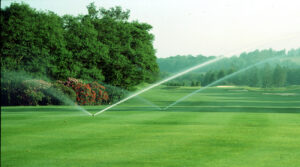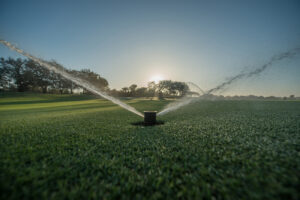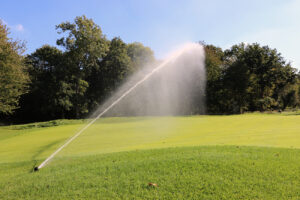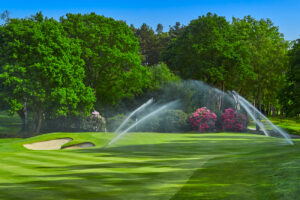How much water do you actually need to apply to turf to keep it healthy?
Related Articles
Peter Robin, Origin Amenity Solutions’ (OAS) irrigation product manager, answers this pivotal question.
Last year caught many golf courses off-guard, and the fallout was golf greens that struggled to survive. Whilst it would be nice to think that last summer was a one-off, we’ve been told that extremes in weather conditions are becoming more prevalent. We can only assume that hot dry summers will return to test your irrigation systems across the UK.
If you don’t apply enough water to keep the turf healthy, the turf will become susceptible to pests and diseases. Many weeds are better at coping with hot, dry conditions, and these will happily compete with your preferred turf species. Plant-pathogenic nematodes will cause far more damage to your turf if the plant roots are struggling. Any rootzone pests that eat your roots will enjoy the warm soil and will proliferate, and the turf won’t be able to replenish new roots fast enough if it is under stress. In other words, if your turf is stressed, you are opening the floodgates to every pest and disease that enjoys attacking stressed turfgrasses, and your turf will be too stressed to compete! Even months after this sort of event, your turfgrasses will struggle with diseases as it tries desperately to recover.
It’s one thing to say we need to apply more water, but how much is enough? How do we know how much water to apply to keep turf healthy?
The simplest way to determine this is to check your daily evaporation rates; you can use readings from a local weather station if one is available (the internet will have local information). On some of those really hot days, the daily evaporation rate across parts of the country were huge, but on average we can assume that the evaporation rate on a hot, dry, low humidity day will be around 5mm (this is the direct opposite to 5mm of rain). Turfgrass doesn’t let water evaporate from the leaf surface as easily as from a puddle, and this difference is called the Transpiration Coefficient.
For a temperate turfgrass we can assume this coefficient is around 0.7, so the resultant daily evapo-transpiration rate is therefore 5mm x 0.7 = 3.5mm. This is the amount of irrigation you need to apply to replenish how much moisture was lost during that hot, dry day. So, each day, find out the evaporation rate and multiply it by 0.7 to get to your evapo-transpiration rate. This is the amount of water you need to re-apply if you want your turf to remain healthy so it can put up a good fight against predators and diseases.
If your green is 400 square metres, and you need to apply 3.5mm across the surface, then this amounts to 1,400 litres across the surface (400m2 x 3.5mm). If you have four sprinklers on the green, then each sprinkler needs to apply 350 litres (1,400 litres / four sprinklers). If each sprinkler’s nozzle flow rate is 60 litres per minute, then the run time per sprinkler will be about six minutes (350 litres /60 lpm).
If you have a day like the ones we had last summer, the evaporation rate might be double this! If that’s the case, you obviously need to operate the irrigation system for proportionally longer.
To not apply enough water is to play roulette with your turfs’ health. If you don’t apply enough water in the evening for what was lost from the soil during the day, the plant will struggle as the soil falls into a deficit. Do this several times on consecutive days and your turf health will plummet. Hoping for a good downpour of rain is just wishful thinking!
Of course, applying this amount of water is all very well but we need to apply it evenly across the surface of the green. How many greenkeepers can say that their sprinklers will achieve this? If your water pressure from your irrigation pump is too low, the sprinkler will tend to ‘dump’ lots of water at the far end of its throw, and parts of the green might even miss getting watered at all (often five or six metres away from the sprinkler), and this can lead to puddling in some places and dry patches in others within the same green. This is why rain is so useful; it falls evenly across the entire surface.
Even the best irrigation system designed by a consultant from scratch is likely to have a uniformity of coverage of 90 percent maximum, and if the water pressure isn’t good enough, then the uniformity of coverage will decrease quite quickly. If your irrigation uniformity is 50 percent for example, which is quite likely if your sprinklers aren’t receiving enough water pressure, then there is a 50 percent difference between the driest spot on your green and the wettest spot. If this is your issue, then you can reduce your sprinkler nozzle sizes (smaller nozzles will reduce the flow rate which in turn will increase your system’s water pressure), maybe install a better pump, and definitely make sure you operate fewer sprinklers at the same time; this allows the pump to deliver more water and pressure to each sprinkler. On your worst greens you might be able to divide sprinklers by putting them on more solenoid valves. This is one of the many reasons why greens sprinklers with inbuilt solenoid valves (electric valve-in-head rotors) are so useful.
So, summing up, if you don’t apply enough water, your turf will struggle in more ways than just being thirsty. If your irrigation system is inadequate then you’ll no doubt see the effects, but you can play with parts of your system to help alleviate this.
This is the basis of the irrigation seminars that Origin Amenity Solutions have been hosting across the UK. If you’d like to participate in the next one in your area, email the team at sales@originamenity.com






























